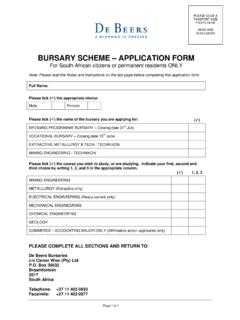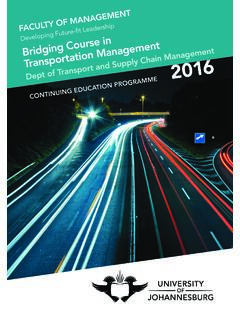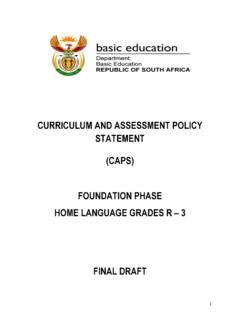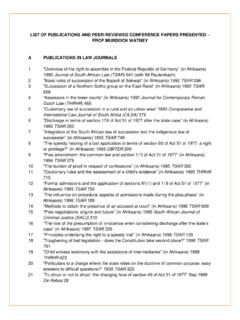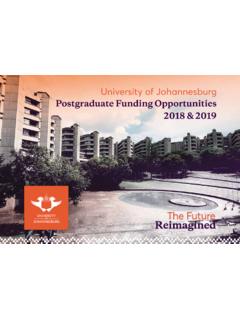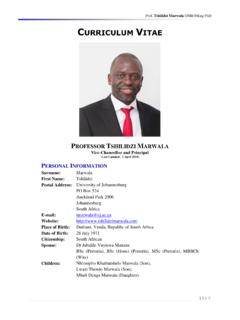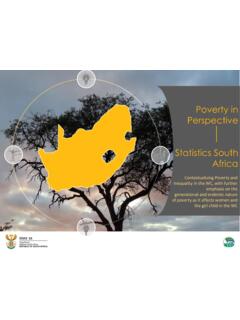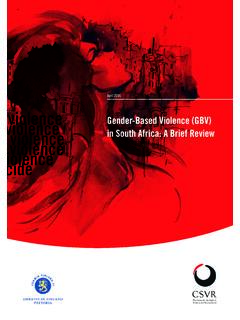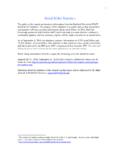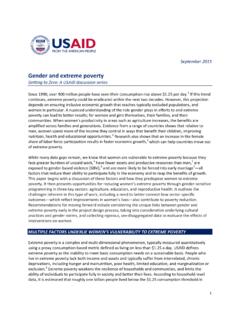Transcription of Poverty, inequality and social exclusion in South Africa ...
1 Poverty, inequality and social exclusion in South Africa : a systematic assessment of key policies, strategies and flagship programmes Submitted to the National Development Agency by the Centre for social Development in Africa (CSDA), University of Johannesburg 31 October 2019. 1. Acknowledgements This review was completed with significant contributions from, and the full cooperation of, the National Development Agency. Their assistance is gratefully acknowledged. The comments and feedback made by NDA colleagues by email and in a discussion following the completion of the draft of the report, have been incorporated into the final version. The report was written by Sophie Plagerson and Senzelwe Mthembu. The data capture and analysis for the study was carried out by Larry Onyango, Dipuo Mokhokane, Madoda Sitshange and Khuliso Matidza. Many thanks to them for their major contribution and insights into the study.
2 Thanks also to Prof Lauren Graham, Sam Murugan, Vinah Adonis for their support and advice throughout the project. Laureen Rushby from the University of Cape Town advised on locating and accessing government documents many thanks for this contribution. Suggested report citation: Plagerson, S. and Mthembu, S. 2019. Poverty, inequality and social exclusion in South Africa : a systematic assessment of key policies, strategies and flagship programmes. CSDA, Johannesburg 2. Acronyms BBBEE Broad-Based Black Economic Empowerment CSDA Centre for social Development in Africa DAFF Department of Agriculture, Forestry and Fisheries DBE Department of Basic Education DEA Department of Environmental Affairs DHET Department of Higher Education and Training DHS Department of Human Settlements DOD Department of Defence DOE Department of Energy DOL Department of Labour DOP Department of Police DPME Department of Planning.
3 Monitoring and Evaluation DPSA Department of Public Service and Administration DPW Department of Public Works DRDLR Department of Rural Development and Land Reform DSBD Department of Small Business Development DSD Department of social Development DTI Department of Trade and Industry DWS Department of Water and Sanitation ECD Early Childhood Development EPWP Expanded Public Works Programme MDG Millennium Development Goal MTSF Medium Term Strategic Framework NDOH National Department of Health NDP National Development Plan NPC National Planning Commission RDP Reconstruction and Development Programme SDG Sustainable Development Goal 3. Contents 1. Introduction 2. Poverty, inequality and social exclusion : a review of the literature Poverty, inequality and social exclusion : definitions and measurement Poverty in South Africa inequality in South Africa social exclusion in South Africa Key socio-economic strategies 3.
4 Aims and objectives 4. Methodology Research design Literature review Assessment criteria development Policy, strategy and programme analysis Limitations of the study 5. Findings: Mainstreaming of poverty, inequality and social exclusion in South Africa 's policy documents Document analysis overview Poverty, inequality and social exclusion in laws, policies and strategies in South Africa : a summary of the findings Poverty inequality social exclusion social exclusion Gender social exclusion Race social exclusion Disability social exclusion Youth not in education, employment or training Spatial exclusion Programmes Targets and monitoring 6. Discussion 7. Recommendations 8. Bibliographic References 4. Poverty, inequality and social exclusion have received global attention in the post-2015. development agenda. Despite significant progress in poverty reduction in many parts of the world, social and economic inequalities persist and vulnerable groups continue to confront barriers that prevent them from fully participating in economic, social and political life.
5 In this context, [I]nclusiveness and shared prosperity have emerged as core aspirations of the 2030. Agenda for Sustainable Development. A central pledge contained in the 2030 Agenda is to ensure that no one will be left behind and to see all goals and targets met for all nations, peoples and for all parts of society, endeavouring to reach the furthest behind first. (UN, 2016). The United Nations Sustainable Development Goals (SDGs) focuses on equity, specifically identifying those who are excluded because of their age, gender, race, ethnicity, disability or migrant status, lack opportunities, resources and influence. With regard to South Africa , the SDGs find expression in the Africa Agenda 2063 and in national monitoring targets, with a focus on the most vulnerable and the extreme poor (StatsSA, 2017). In line with global development agendas, for more than two decades, South Africa has sought to address poverty and inequality with a wide range of initiatives (World Bank, 2018).
6 As stated in the Reconstruction and Development Programme (RDP) (1994) and reiterated in the National Development Plan (NDP) (2012), "no political democracy can survive and flourish if the mass of our people remain in poverty, without land, without tangible prospects for a better life attacking poverty and deprivation must therefore be the first priority of a democratic government". For example, the social wage' has been used as a redistributive mechanism of the government budget deliberately aimed at improving the lives of the poor and reducing their cost of living. This has been achieved through several interventions including free primary health care, no-fee paying schools, old age and child support grants, housing, and free basic services (water, electricity and sanitation) to poor households. Although these policy frameworks have resulted in notable gains in poverty reduction since 1994, the country continues to face the challenge of high poverty, high inequality and high unemployment.
7 Figure 1 gives a Scorecard' summarizing progress over a five (2011-2015). and a ten year (2006-2015) period. Many indicators have improved over the 10 year period but worsened or stagnated over the 5 year period. Income inequality levels are among the highest in the world. South Africa has made progress in reducing poverty over the past two decades, but high inequality acts as a brake on poverty reduction, and poverty rates remain high. South Africans remain sharply divided along racial and socioeconomic lines, even though discriminatory laws have been abolished (David et al., 2018). In the past five years, poverty has increased and over half the population are poor ( statistics South Africa , 2017). Child poverty rates are disproportionately high. In 2014, the top 10% of the population received two thirds of national income, while the top 1% received 20% of national income (Alvaredo et al.)
8 , 2018). 5. Figure 1. Poverty, inequality and social exclusion progress scorecard Change over 5. Change over 10. Indicator years (2011- years (2006-2015). 2015). Low income Better Worse Food poverty Better Worse Multidimensional poverty Better Poverty Access to electricity Better Better Improved water source Better Better Unemployment Better Worse Income Better Better inequality Wealth Worse Wage Worse Worse Sense of alienation between groups No change No change social exclusion social cohesion index Mixed Low income poverty - Women Better Worse Gender Low income - gap between men and women Better Worse Low income - Children Better Worse Infant mortality Better Better Age Unemployed youth Worse1 Worse Low income - Older persons Better Worse Population Low income - Black Africans Better Worse group Low income - Gap between groups Better Worse Low income - Gap between provinces Better Worse Spatial Low income - Rural Better Worse Low income - Rural/urban gap Worse Worse 1.
9 Calculated over timespan 2008-2015. Data sources: StatsSA (2015); StatsSA (2017); World Bank (2018); Mbewe and Woolard (2016); Njozela et al. (2016); Dorrington et al. (2016); WB Indicators Towards the promotion of greater inclusiveness and equity in access to services, resources, and opportunities; greater empowerment of disadvantaged and marginalized groups to participate in social , economic, and political life; and greater security to cope with chronic or sudden risks, especially for poor and vulnerable groups, this project is premised on the understanding that policies matter and can make a real difference, and are a significant component of efforts to address poverty and inequality . For discrimination to be reversed, barriers including legislation and policies that prevent participation need to be addressed. This project therefore examines whether the commitments expressed in key policy documents to address poverty and inequality have been endorsed across social and economic policies, strategies and programmes.
10 The study assesses whether these are inclusive and adequately address and prioritise reduction of poverty and inequality ; and provide a basis for mainstreaming equity and poverty reduction in South Africa 's policies, strategies and programmes. For each policy, strategy and programme across socio- economic sectors, this project seeks to determine whether poverty, inequality and equity considerations are recognized, and for each sector whether targets are set, and whether the realization of these targets is actively and routinely monitored. The project is aligned with the realisation of the National Development Plan, and with the strategic outcomes of the Medium Term Strategic Framework 2014-2019 (Republic of South Africa , 2014). In line with the mandate of the National Development Agency, the findings of this study are intended to inform public debate around development in South Africa .

